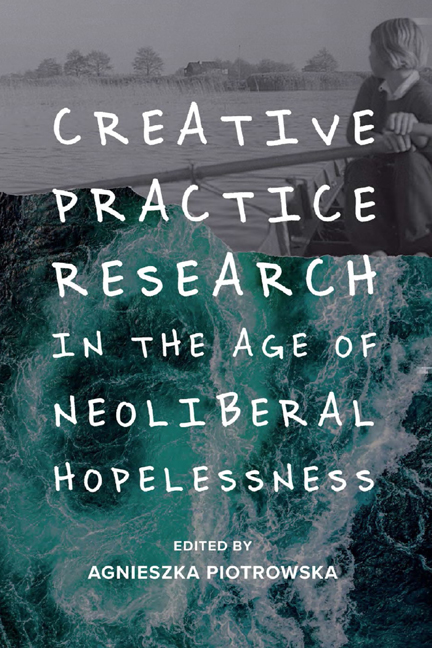Book contents
- Frontmatter
- Contents
- List of Figures
- Notes on Contributors
- Acknowledgements
- Preface: Life in the Post Pandemic Age
- Dedication
- 1 Introduction: Complexities, Compromises and Complicities
- 2 Against the Grain: Women Film Practitioners and Theorists Talk Creative Practice and Theory
- 3 Married to the Eiffel Tower: Notes on Love, Loss and Knowledge
- 4 Creativity and Neoliberalism: Between Autonomy, Resistance and Tactical Compliance
- 5 Tactical Compliance and the Persistence of Elsaesser
- 6 Storytelling and Game Playing
- 7 Autonomy and the Other Woman: Queer Active Agency and Postcolonial Expectations
- 8 From Neolithic to Neoliberal
- 9 First-person Expression on ‘Non-Western’ Screens: China as a Case Study
- 10 Scholarly Exploration of the Creative Process: Integrating Film Theory and Practice
- 11 Teaching Practice as Theory: Guerrilla Filmmaking
- 12 Baits of Falsehood: The Role of Fiction in Documentary or From Untheorised Practice to Unpractised Theory
- 13 Repented: A Creative Intersemiotic Translation
- Notes on Repented
- 14 How do you see me? The Camera as Transitional Object in Diasporic, Domestic Ethnography
- 15 ‘Shut Your Hole, Girlie. Mine's Making Money, Doll’: Creative Practice-Research and the Problem of Professionalism
- 16 Feminist ‘Pensive-creative Praxis’ and Irigaray: A Porous, Dialogical Encounter
- 17 The Paths of Creation, or How Can I Help my Dybbouk to Get Out of Me?
- 18 ‘We Want to Kill Boko Haram’: Reflections on the Photographic Representation of Children in a Displacement Camp
- 19 Between ‘Counter-movement’ (Ingold) and ‘Living with Ghosts’ (Demos)
- 20 Screen Memories: A Video Essay on Smultronstället/Wild Strawberries
- Index
20 - Screen Memories: A Video Essay on Smultronstället/Wild Strawberries
Published online by Cambridge University Press: 17 October 2020
- Frontmatter
- Contents
- List of Figures
- Notes on Contributors
- Acknowledgements
- Preface: Life in the Post Pandemic Age
- Dedication
- 1 Introduction: Complexities, Compromises and Complicities
- 2 Against the Grain: Women Film Practitioners and Theorists Talk Creative Practice and Theory
- 3 Married to the Eiffel Tower: Notes on Love, Loss and Knowledge
- 4 Creativity and Neoliberalism: Between Autonomy, Resistance and Tactical Compliance
- 5 Tactical Compliance and the Persistence of Elsaesser
- 6 Storytelling and Game Playing
- 7 Autonomy and the Other Woman: Queer Active Agency and Postcolonial Expectations
- 8 From Neolithic to Neoliberal
- 9 First-person Expression on ‘Non-Western’ Screens: China as a Case Study
- 10 Scholarly Exploration of the Creative Process: Integrating Film Theory and Practice
- 11 Teaching Practice as Theory: Guerrilla Filmmaking
- 12 Baits of Falsehood: The Role of Fiction in Documentary or From Untheorised Practice to Unpractised Theory
- 13 Repented: A Creative Intersemiotic Translation
- Notes on Repented
- 14 How do you see me? The Camera as Transitional Object in Diasporic, Domestic Ethnography
- 15 ‘Shut Your Hole, Girlie. Mine's Making Money, Doll’: Creative Practice-Research and the Problem of Professionalism
- 16 Feminist ‘Pensive-creative Praxis’ and Irigaray: A Porous, Dialogical Encounter
- 17 The Paths of Creation, or How Can I Help my Dybbouk to Get Out of Me?
- 18 ‘We Want to Kill Boko Haram’: Reflections on the Photographic Representation of Children in a Displacement Camp
- 19 Between ‘Counter-movement’ (Ingold) and ‘Living with Ghosts’ (Demos)
- 20 Screen Memories: A Video Essay on Smultronstället/Wild Strawberries
- Index
Summary
[Screen memory]: a recollection of early childhood that may be falsely recalled or magnified in importance and that masks another memory of deep emotional significance.
(Merriam-Webster Dictionary)Screen Memories is a short split-screen video that began as a piece of free-associational audiovisual exploration. Rather than an explicit work of scholarly exposition, explication or argumentation, it is an instance of creative practice as a mode of enquiry: a concise compilation made to perform or frame a new audiovisual encounter – in this case turning on a technique of gentle defamiliarisation (Ostranenie) – in order to engender new material thinking and feeling. As film historian and theorist Pam Cook has noted, in relation to her own practical exploration of videographic film and television studies, audiovisual forms like this
can produce a ‘writerly’ experience a la Roland Barthes in which viewers / readers / essayists generate their own meanings. The video essay constitutes an event; it transforms existing material to fashion an open-ended process of re-reading and re-writing. (Cook 2014)
Given this open-endedness, what follows is a written exegesis and contextualisation of the video that aim to expand on its central topic and to make more manifest its audiovisual methodology. I provide this in order to situate the video even more clearly as practice-led research, that is as a work attempting to produce new knowledge, both through its particular form and through the reflections generated by this.
Screen Memories is one of a number of videographic works of spatial montage that I made about Ingmar Bergman's films to be screened at events to mark the one-hundredth anniversary of the Swedish director's birth on 14 July 1918. Each of these works uses its multiple-screen form in the service of a poetic analysis through synchronous performance, a playing together of cinematic motifs, similarities, repetitions or variations that would otherwise only be meaningfully apprehended as such sequentially in the audiovisual time-based medium. In their double unfolding, across screens, of the already ‘profuse simultaneity of signifiers’ (Burch 1981: 29) in any single collection of frames from Bergman's cinematic sequences, these videos also explore, as a compositional principle, art historian and theorist Roger Cardinal's notions of the ‘haptic mosaic’ in pictorial culture (Cardinal 1986: 127).
- Type
- Chapter
- Information
- Creative Practice Research in the Age of Neoliberal Hopelessness , pp. 304 - 315Publisher: Edinburgh University PressPrint publication year: 2020



